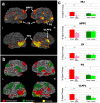Brain Activity Dissociates Mentalization from Motivation During an Interpersonal Competitive Game
- PMID: 20072709
- PMCID: PMC2804999
- DOI: 10.1007/s11682-008-9047-y
Brain Activity Dissociates Mentalization from Motivation During an Interpersonal Competitive Game
Abstract
Studies demonstrating selective brain networks subserving motivation and mentalization (i.e. attributing states of mind to others) during social interactions have not investigated their mutual independence. We report the results of two fMRI studies using a competitive game requiring players to use implicit 'on-line' mentalization simultaneously with motivational processes of gains and losses in playing against a human or a computer opponent. We delineate a network, consisting of bilateral temporoparietal junction, temporal pole (TP), medial prefrontal cortex (MPFC) and right fusiform gyrus, which is sensitive to the opponent's response (challenging>not challenging the player) and opponent type (human>computer). This network is similar to a known explicit 'off-line' mentalization circuit, suggesting its additional involvement in implicit 'on-line' mentalization, a process more applicable to real-life social interactions. Importantly, only MPFC and TP were selective to mentalization compared to motivation, highlighting their specific operation in attributing states of mind to others during social interactions.
Figures




Similar articles
-
Mentalizing and motivation neural function during social interactions in autism spectrum disorders.Neuroimage Clin. 2013 Sep 19;3:321-31. doi: 10.1016/j.nicl.2013.09.005. eCollection 2013. Neuroimage Clin. 2013. PMID: 24273716 Free PMC article.
-
Cooperate or aggress? An opponent's tendency to cooperate modulates the neural dynamics of interpersonal cooperation.Neuropsychologia. 2021 Nov 12;162:108025. doi: 10.1016/j.neuropsychologia.2021.108025. Epub 2021 Sep 21. Neuropsychologia. 2021. PMID: 34560141 Clinical Trial.
-
Mentalizing in an economic games context is associated with enhanced activation and connectivity in the left temporoparietal junction.Soc Cogn Affect Neurosci. 2023 Jun 5;18(1):nsad023. doi: 10.1093/scan/nsad023. Soc Cogn Affect Neurosci. 2023. PMID: 37130081 Free PMC article.
-
Effects of Different Opponent Types on Motivation and Exercise Intensity in a Competitive Arm Exercise Game.Games Health J. 2020 Feb;9(1):31-36. doi: 10.1089/g4h.2019.0028. Epub 2019 Oct 31. Games Health J. 2020. PMID: 31670574 Free PMC article. Review.
-
[Differences in implicit and spontaneous mentalization in schizophrenia].Psychiatr Hung. 2021;36(1):67-80. Psychiatr Hung. 2021. PMID: 33686016 Review. Hungarian.
Cited by
-
Anodal tDCS Over the Right Temporoparietal Junction Lowers Overbidding in Contests.Front Neurosci. 2019 Jun 11;13:528. doi: 10.3389/fnins.2019.00528. eCollection 2019. Front Neurosci. 2019. PMID: 31244591 Free PMC article.
-
Specific default mode subnetworks support mentalizing as revealed through opposing network recruitment by social and semantic FMRI tasks.Hum Brain Mapp. 2015 Aug;36(8):3047-63. doi: 10.1002/hbm.22827. Epub 2015 May 6. Hum Brain Mapp. 2015. PMID: 25950551 Free PMC article.
-
Default mode network modulation by mentalizing in young adults with autism spectrum disorder or schizophrenia.Neuroimage Clin. 2020;27:102343. doi: 10.1016/j.nicl.2020.102343. Epub 2020 Jul 8. Neuroimage Clin. 2020. PMID: 32711391 Free PMC article.
-
Neural Mechanisms of Vicarious Reward Processing in Adults with Autism Spectrum Disorder.Autism Res Treat. 2020 Mar 21;2020:8014248. doi: 10.1155/2020/8014248. eCollection 2020. Autism Res Treat. 2020. PMID: 32257439 Free PMC article.
-
Avoidant Responses to Interpersonal Provocation Are Associated with Increased Amygdala and Decreased Mentalizing Network Activity.eNeuro. 2017 Jun 27;4(3):ENEURO.0337-16.2017. doi: 10.1523/ENEURO.0337-16.2017. eCollection 2017 May-Jun. eNeuro. 2017. PMID: 28660251 Free PMC article.
References
-
- Adolphs R. Cognitive neuroscience of human social behaviour. Nature Reviews. Neuroscience. 2003;4:165–178. doi:10.1038/nrn1056. - PubMed
-
- Amodio D, Frith C. Meeting of minds: the medial frontal cortex and social cognition. Nature Reviews. Neuroscience. 2006;7:268–277. doi:10.1038/nrn1884. - PubMed
-
- Beauchamp MS, Lee KE, Argall BD, Martin A. Integration of auditory and visual information about objects in superior temporal sulcus. Neuron. 2004;41:809–823. doi:10.1016/S0896-6273(04)00070-4. - PubMed
-
- Buckner RL, Carroll DC. Self-projection and the brain. Trends in Cognitive Sciences. 2007;11:49–57. doi:10.1016/j.tics.2006.11.004. - PubMed
-
- Bunge SA. How we use rules to select actions: a review of evidence from cognitive neuroscience. Cognitive, Affective & Behavioral Neuroscience. 2004;4:564–579. - PubMed
Grants and funding
LinkOut - more resources
Full Text Sources
